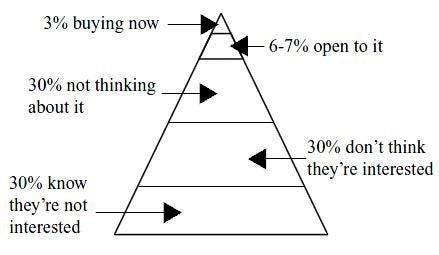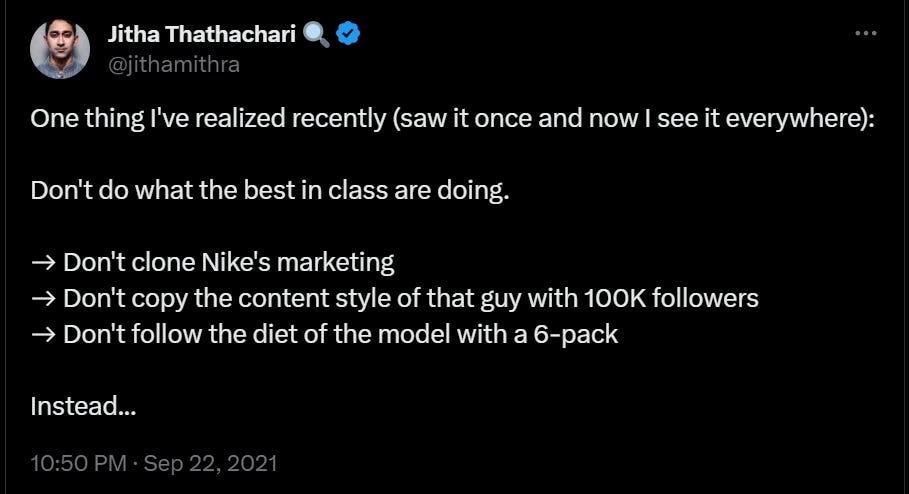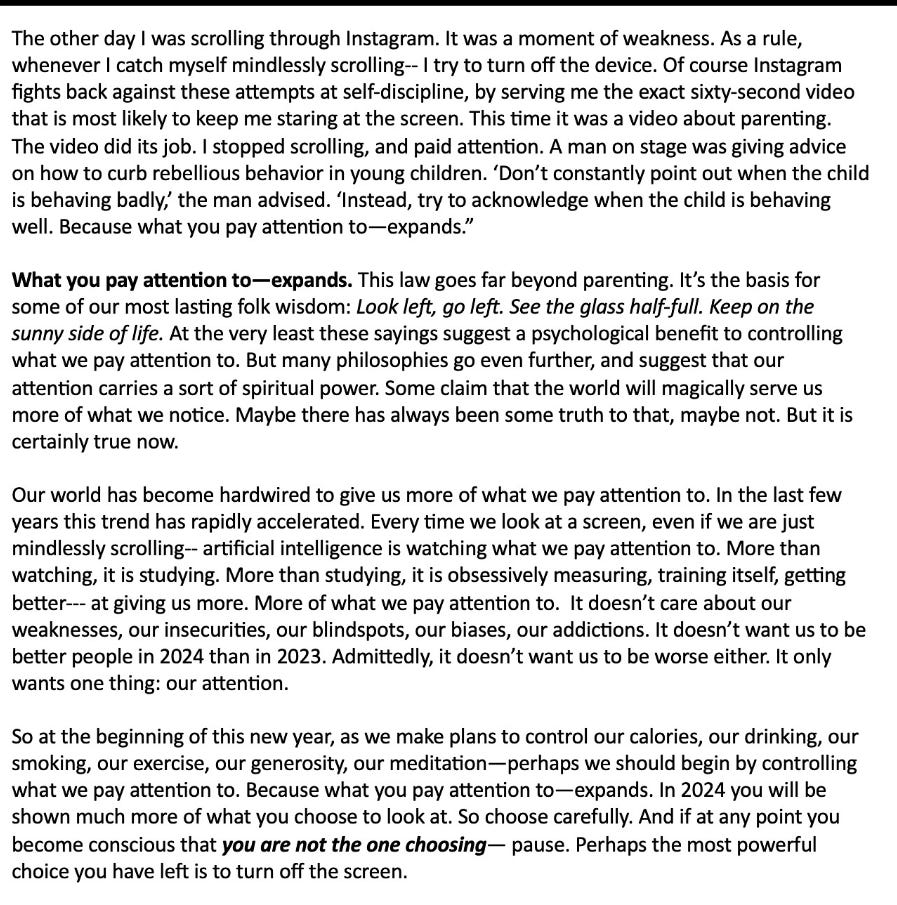Sunday Reads #187: Do you know whom you're marketing to? Do you, really?
The job of Marketing is not to close a sale. And Sales is not about selling either.
Hey there! Hope you've had a great start to the year!
It's been a while since I wrote to you. I've missed you all!
Been quite busy these last few months, so wasn't able to commit enough time to write something good.
Busy with what? Well, work, life, and... one more thing.
🥁🥁🥁
I'm starting a fund!
It's a seed fund, investing in amazing early-stage startups and founders.
Drop me a note (just hit reply) if you want to learn more about how you can participate in the fund.
And please refer me amazing founders you know, even if they are between ventures (feel free to refer yourself!).
My philosophy on seed-stage investing is here.
With that update out of the way, let's get into it - the first Sunday Reads of 2024!
To refresh (for myself as well as for you), this is what we do here at Sunday Reads, every week:
We look for cheat codes to life, business, and careers (sometimes we even find them!).
Here’s the last edition of my newsletter: Don't get your ideas from customers (sometimes, listening to your customers can kill your company).
Today, we talk about a simple - deceptively simple - diagram.
1. The Buyer's Pyramid - Do you know whom you’re marketing to?
I saw this diagram a few weeks ago, and I'm still thinking about it. (source). It explains so much about the difficulties of my startup journey.

Why am I still thinking about this simple diagram? Isn’t it an obvious fact?
Yes, but it's one of those rare insights that seem obvious... only in retrospect.
It has three important lessons for entrepreneurs and executives:
Lesson 1: Qualify, qualify, qualify.
I've written before about this famous anecdote from Gary Halbert, the most successful direct marketer ever:
One of the questions I like to ask my students is, "If you and I both owned a hamburger stand and we were in a contest to see who would sell the most hamburgers, what advantages would you most like to have on your side?"
The answers vary. Some people say they would like to have the advantage of having superior meat from which to make their hamburgers. Others say they want sesame seed buns. Others mention location. Someone usually wants to be able to offer the lowest prices.
And so on.
Anyway, after my students are finished telling what advantages they would most like to have, I say to them: "OK, I'll give you every single advantage you asked for. I, myself, only want one advantage and, if you will give it to me, I will whip the pants off of all of you when it comes to selling burgers!"
"What advantage do you want?", they ask.
"The only advantage I want, " I reply, "is a STARVING CROWD!"
The no. 1 principle of Direct Marketing is: Qualify the funnel. Find the starving crowd.
Find the 3% who are ready to buy NOW.
Mark Cranney of Andreessen Horowitz says the same thing, in If SaaS products sell themselves, why do we need sales?.
Sales is not about selling. Sales is about qualifying the buyer.
Find the right buyer, and your product will sell itself.
Lesson 2: If you're a baby, don't copy a teenager.
I first realized this back in Sep 2021. As I wrote in Why Warren Buffett's investing principles won't work for you:

When you've just started your company - when you're looking for Product-Market Fit - your job is not to market to the whole addressable market.
No, your job is to qualify, qualify, qualify.
Find the 3% who are ready to buy NOW. So you can see if your product actually works.
Trying to sell to EVERYONE from Day 1 won't work. It's like playing a video game for the first time, and immediately having to kill the Final Boss.
It's not gonna happen. The Final Boss is not ready to die by your hand. Not yet.
Aside: This framework explains the amount of rejection startup founders face.
We see this so often in origin stories. Having to knock on a hundred doors to get the first "Yes" (and the rest is history). I also still remember - like it was yesterday - the number of NOs I got.
The Buyer's Pyramid tells us why.
You, the founder, might not know it at that time. But what you're doing is not "selling" (trying to convince people to buy).
What you're doing is "qualifying" (finding that first customer who's already 80% convinced).
You're trying to find that 3%.
Once you get to PMF and you're looking to find the next set of buyers, then you can look at the other parts of the pyramid.
Which brings us to lesson 3...
Lesson 3: What job is your marketing doing?
With the framing of the Buyer's Pyramid, you can define the job of marketing a lot better:
You're not trying to get people to buy. You're just trying to move them up the pyramid.
You cannot talk to your entire addressable market in the same way. Depending on where the customer is in the pyramid, you have to talk to them differently.
Marketing is not about closing the sale. It's about getting people one step closer to buying.
I see this at work all the time.
I don't expect to close a new partner in my first, second, or even my fifth conversation. Some of my sales cycles are 2-3 years long! (why this works, btw, is because our customer relationships tend to run for decades).
When you take this perspective - moving people one step closer to buying - then the job of marketing... is different at every stage!
Bottom 30% - filter them out.
Middle 60% - catch their attention. And then educate them.
Like a street performer - your marketing must be eye-catching and thought-provoking. Like a good first tweet, it should "stop the scroll". Pique their interest.
At this stage, you're building demand that you can harvest in the future. It's not about this month's (or sometimes even this year's) sales target.
7% open to consideration - nurture them.
Send them case studies. Show them how this can generate value right away.
Move them up the pyramid.
3% ready to buy - give them offers to close.
Flash discounts, one-time only offers, the works. Make it easy to say yes.
TL:DR:
Sales is not about selling. Sales is about qualifying. Sales is about finding the Starving Crowd.
As an early-stage startup, your job is not to sell. Your job is to find the one customer (or three) that get you to PMF. Don't follow the marketing playbook of a large company.
The job of marketing is not closing a sale. The job of marketing is to move customers one step closer to buying. And how you market at each step, will be different.
In Bruce Springsteen's famous words:
Can't start a fire...
Can't start a fire without a spark.
Find the spark first. Then light the fire.
Before we continue, a quick note:
Did a friend forward you this email?
Hi, I’m Jitha. Every Sunday I share ONE key learning from my work in business development and with startups; and ONE (or more) golden nuggets. Subscribe (if you haven’t) and join 1,600+ others who read my newsletter every week (its free!) 👇
2. Golden Nugget of the week.
Saw this on Instagram a few days ago.
Ironic, I know, that I saw this on Instagram of all places.
Nevertheless, it's a good reminder:
What you pay attention to - expands.
In the new year, let's be more mindful of what we pay attention to.
3. What exactly are AI Large Language Models? How do they work?
2023 was the year of ChatGPT, Large Language Models, and Artificial Intelligence.
This YouTube video from Andrej Karpathy of OpenAI is a great primer into how these AI models work. And why they're such an important breakthrough.
4. Good to know that innovation is alive and well 😂
I'm glad that AI has helped companies do more for consumers.
For example, how else would we get... Doritos Crunch Cancellation Software?
While PepsiCo’s Doritos chips are popular with gamers, the loud crunch they make has long been a source of frustration.
The beverage and snacking giant estimated that 85% percent of U.S. gamers have consumed Doritos in the past three months. But at the same time, nearly a third of individuals reported that other people’s crunching distracts them from playing well and impacts their performance.
To “help gamers keep the crunch to themselves,” Doritos is debuting what it calls “Doritos Silent.” Gamers download Doritos Crunch Cancellation software and when the technology is turned on, the software detects the crunching sounds and silences it while keeping the gamer’s voice intact.
The software, which took six months to develop, used artificial intelligence and machine learning to analyze more than 5,000 different crunch sounds.
At times like these, I have to say: Don't you love capitalism! 🙃
That’s it for this week. Hope you enjoyed it.
Wish you a happy, healthy, productive… and more mindful year ahead.
I’ll see you next week.
Jitha
[A quick request - if you liked today’s newsletter, I’d appreciate it very much if you could forward it to one other person who might find it useful 🙏].





Great to hear that you're starting a fund, Jitha! I'll be sure to keep you in mind when I come across founders.
Great post Jitha, as always, and good to see you back! :)